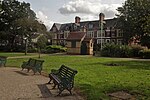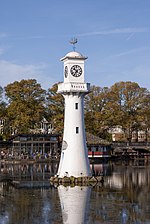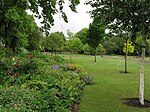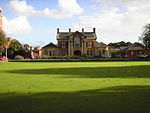
Cathays Park or Cardiff Civic Centre is a civic centre area in the city centre of Cardiff, the capital city of Wales, consisting of a number of early 20th century buildings and a central park area, Alexandra Gardens. It includes Edwardian buildings such as the Temple of Peace, City Hall, the National Museum and Gallery of Wales and several buildings belonging to the Cardiff University campus. It also includes Cardiff Crown Court, the administrative headquarters of the Welsh Government, and the more modern Cardiff Central police station. The Pevsner architectural guide to the historic county of Glamorgan judges Cathays Park to be "the finest civic centre in the British Isles". The area falls within the Cathays electoral ward.

Bute Park and Arboretum is a park in Cardiff, Wales. It comprises 130 acres (53 ha) of landscaped gardens and parkland that once formed the grounds of Cardiff Castle. The park is named after the 3rd Marquess of Bute, whose family owned the castle.

Roath Park Cardiff, Wales, is one of Cardiff's most popular parks, owned by Cardiff County Council and managed by the Parks Section. It retains a classic Victorian atmosphere and has many facilities. The park has recently been awarded the prestigious Green Flag award to recognise its high quality and its importance to Cardiff. Roath Park has widely diverse environments across the park.

Cefn Onn Halt railway station was a halt on the Rhymney Line between Cardiff and Rhymney, Wales opened in 1915. It closed on 27 September 1986 and was replaced by Lisvane and Thornhill, a short distance to the south. The station is close to the entrance of Caerphilly Tunnel, which resulted in trains overshooting the platform and having to reverse.

The Cathays Cemetery is one of the main cemeteries of Cardiff, Wales. It is in the Cathays district of the city, about 1.5 miles (2.4 km) north of Cardiff city centre. At 110 acres it is the third largest cemetery in the United Kingdom. It is listed on the Cadw/ICOMOS Register of Parks and Gardens of Special Historic Interest in Wales.

Sophia Gardens is a public park in Riverside, Cardiff, Wales, on the west bank of the River Taff. International test cricket matches and county cricket matches are held in the Sophia Gardens cricket ground, the home of Glamorgan County Cricket Club. The gardens are listed on the Cadw/ICOMOS Register of Parks and Gardens of Special Historic Interest in Wales.

There are around 1,000 listed buildings in Cardiff, the capital city of Wales. A listed building is one considered to be of special architectural, historical or cultural significance, which is protected from being demolished, extended or altered, unless special permission is granted by the relevant planning authorities. The Welsh Government makes decisions on individual cases, taking advice from the heritage agency Cadw, the Royal Commission on the Ancient and Historical Monuments of Wales and local councils.

Craig-y-parc House is a country house in Pentyrch, Cardiff, Wales. Dating from 1914 to 1918, it was built for Thomas Evans, a colliery owner, by Charles Edward Mallows. The house reputedly cost £100,000. Craig-y-parc is a Grade II* listed building. The garden and park surrounding the house has its own Grade II* listing on the Cadw/ICOMOS Register of Parks and Gardens of Special Historic Interest in Wales, is a designated conservation area and contains a number of listed structures. The house now operates as a residential school for children and young adults with disabilities.

Ty Gwyn is a large detached house in the Cardiff suburb of Lisvane. It is set in 5 acres of grounds and is 10,000sq ft in size.

Bridgend County Borough is a county borough in south-east Wales. It covers an area of 251 km2 (97 sq mi). In 2021 the population was approximately 145,800.

Caerphilly County Borough is a county borough in south-east Wales. It covers an area of 227 km2 (88 sq mi). In 2021 the population was approximately 176,000.

The Vale of Glamorgan is a county borough in south-east Wales. It covers an area of 331 km2 (128 sq mi) and in 2021 the population was approximately 132,500.

Neath Port Talbot is a county borough in South Wales. It covers an area of 441 km2 (170 sq mi) and in 2021 the population was approximately 141,900.

The City and County of Swansea is a principal area in south Wales. It covers an area of 380 km2 (150 sq mi) and in 2021 the population was approximately 237,800.

Carmarthenshire is a county in the south-west of Wales. It covers an area of 2,370 km2 (920 sq mi). In 2021 the population was approximately 188,200.

Ceredigion is a county in the west of Wales. It covers an area of 1,785 km2 (689 sq mi) and in 2021 the population was approximately 70,700.

Wrexham County Borough is a county borough in the north-east of Wales. It covers an area of 503.7 km2 (194.5 sq mi) and in 2021 the population was approximately 135,100.
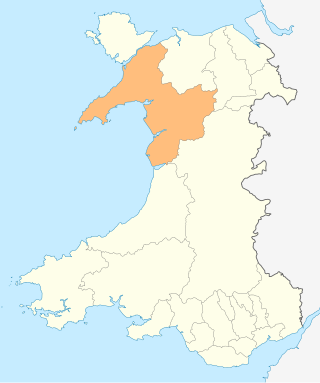
Gwynedd is a county in the north-west of Wales. It covers an area of 2,535 km2 (979 sq mi) and in 2021 the population was approximately 117,100.

Flintshire is a county in the north-east of Wales. It covers an area of 437.5 km2 (168.9 sq mi) and in 2021 the population was approximately 155,100.

Andrew Pettigrew (1833–1903) was a Scottish landscape gardener. Much of his career was spent as head gardener to John Crichton-Stuart, 3rd Marquess of Bute, firstly at Dumfries House and then at Bute's Welsh estate centred on Cardiff Castle. His three sons, William Wallace, Hugh Allan and Andrew Alexander, also became landscape gardeners and they together created many of Cardiff's most notable parks, including Bute Park, Cathays Park, Llandaff and Pontcanna Fields, and Roath Park. The Glamorgan Archives, which holds the records of Cardiff County Borough Council containing materials relating to the development of the city's parks, describes them collectively as "the family who landscaped Cardiff".





